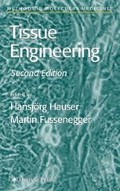Summary
Tissue engineering has attracted wide interest as a potential method to alleviate the shortage of transplantable organs (1). To date, almost all of the successfully engineered tissues/organs have relatively thin and/or avascular structures [e.g., skin (2), cartilage (3), and bladder (4), where postimplantation vascularization from the host (angiogenesis) is sufficient to meet the implant’s demand for oxygen and nutrients. Vascularization remains a critical obstacle impeding attempts to engineer thicker, metabolically demanding organs, such as heart and liver. One approach in vascularizing an engineered tissue is to add the cellular components of blood vessels (endothelial and perivascular cells) directly to the tissue–engineered construct. We have shown that coimplanting endothelial cells and perivascular cells in a scaffold in vivo can lead to the formation of a vascular network that anastomoses to the host circulatory system. The engineered vessels are stable and functional, and they persist for more than 1 year in vivo. This approach may potentially lead to the creation of a well–vascularized–engineered tissue.
Access this chapter
Tax calculation will be finalised at checkout
Purchases are for personal use only
References
Vacanti, J. P. and Langer, R. (1999) Tissue engineering: the design and fabrication of living replacement devices for surgical reconstruction and transplantation. Lancet 354(Suppl. 1), SI32–SI34.
Compton, C. C., Butler, C. E., Yannas, I. V., Warland, G., and Orgill, D. P. (1998) Organized skin structure is regenerated in vivo from collagen– GAG matrices seeded with autologous keratinocytes. J. Invest. Dermatol. 110, 908–916.
Vunjak–Novakovic, G., Obradovic, B., Martin, I., Bursac, P. M., Langer, R., and Freed, L. E. (1998) Dynamic cell seeding of polymer scaffolds for cartilage tissue engineering. Biotechnol. Prog. 14, 193–202.
Atala, A., Bauer, S. B., Soker, S., Yoo, J. J., and Retik, A. B. (2006) Tissue–engineered autologous bladders for patients needing cystoplasty. Lancet 367, 1241–1246.
Jain, R. K., Au, P., Tam, J., Duda, D. G., and Fukumura, D. (2005) Engineering vascularized tissue. Nat. Biotechnol. 23, 821–823.
Blau, H. M. and Banfi, A. (2001) The well–tempered vessel. Nat. Med. 7, 532–534.
Levenberg, S., Rouwkema, J., Macdonald, M., Garfein, E. S., Kohane, D. S., Darland, D. C., Marini, R., van Blitterswijk, C. A., Mulligan, R. C., D’Amore, P. A., and Langer, R. (2005) Engineering vascularized skeletal muscle tissue. Nat. Biotechnol. 23,879–884.
Koike, N., Fukumura, D., Gralla, O., Au, P., Schechner, J. S., and Jain, R. K. (2004) Tissue engineering: creation of long–lasting blood vessels.Nature 428, 138–139.
Wang, Z. Z., Au, P., Chen, T., Shao, Y., Daheeon, L. M., Bai, H., Arzigian, M., Fukumura, D., Jain, R. K., Scadden, D. T. (2007) Endothelial cells derived from embryonic stem cells form durable blood vessels in vivo. Nat. Biotechnol. 25, 317–318.
Jain R. K., Booth, M. F., Padera T. P., Munn L. L., Fukumura D., Brown, E. (in press) Applications of Non–Linear Intravital Microscopy, in Handbook of Biological Nonlinear Optical Microscopy (So, P., Masters, B., eds), Oxford University Press, Oxford, UK.
Jain, R. K. (2003) Molecular regulation of vessel maturation. Nat. Med. 9, 685–693.
Yuan, F., Leunig, M., Berk, D. A., and Jain, R. K. (1993) Microvascular permeability of albumin, vascular surface area, and vascular volume measured in human adenocarcinoma LS174T using dorsal chamber in SCID mice. Microvasc. Res. 45, 269–289.
Yang, S., Grahm, J., Kahn, J. W., Schwartz, E. A., Gereitsen, M. E., (1999) Functional coles for PECAM–1 (C031) and VE–Cadherin (CD144) in tube assembly and Lumen formation in three–dimensional collagen gels. Am J. Pathol. 155, 887–895.
Monsky, W. L., Fukumura, D., Gohongi, T., Ancukiewcz, M., Weich, H. A., Torchilin, V. P., Yuan, F., and Jain, R. K. (1999) Augmentation of transvascular transport of macromolecules and nanoparticles in tumors using vascular endothelial growth factor. Cancer Res. 59, 4129–4135.
Yuan, F., Salehi, H. A., Boucher, Y., Vasthare, U. S., Tuma, R. F., and Jain, R. K. (1994) Vascular permeability and microcirculation of gliomas and mammary carcinomas transplanted in rat and mouse cranial windows. Cancer Res. 54, 4564–4568.
Dellian, M., Witwer, B. P., Salehi, H. A., Yuan, F., and Jain, R. K. (1996) Quantitation and physiological characterization of angiogenic vessels in mice: effect of basic fibroblast growth factor, vascular endothelial growth factor/vascular permeability factor, and host microenvironment. Am. J. Pathol. 149, 59–71.
Fukumura, D., Gohongi, T., Kadambi, A., Izumi, Y., Ang, J., Yun, C. O., Buerk, D. G., Huang, P. L., and Jain, R. K., Huang, P. L., and Jain, R. K. (2001) Predominant role of endothelial nitric oxide synthase in vascular endothelial growth factor–induced angiogenesis and vascular permeability. Proc. Natl. Acad. Sci. U. S. A. 98, 2604–2609.
Acknowledgments
This work was supported by a Program Project Grant (P01CA80134) and Bioengineering Research Partnership Grant (R01 CA85140) to R. K. J. and D. F., an R01 Grant (CA96915) to D. F., and American Heart Association Pre–doctoral Fellowship to P. A.
Author information
Authors and Affiliations
Editor information
Editors and Affiliations
Rights and permissions
Copyright information
© 2008 Humana Press Inc.
About this protocol
Cite this protocol
Au, P., Tam, J., Fukumura, D., Jain, R.K. (2008). Small Blood Vessel Engineering. In: Hauser, H., Fussenegger, M. (eds) Tissue Engineering. Methods in Molecular Medicine™, vol 140. Humana Press. https://doi.org/10.1007/978-1-59745-443-8_11
Download citation
DOI: https://doi.org/10.1007/978-1-59745-443-8_11
Publisher Name: Humana Press
Print ISBN: 978-1-58829-756-3
Online ISBN: 978-1-59745-443-8
eBook Packages: Springer Protocols

